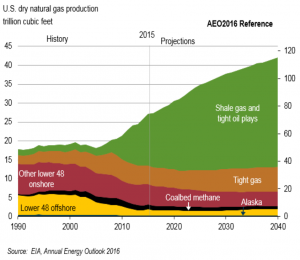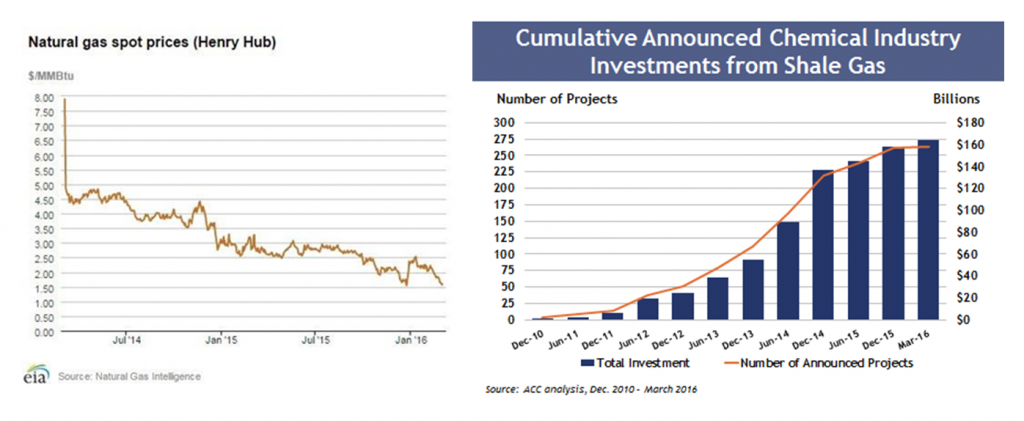Natural gas continues to play a starring role in our nation’s energy story, revitalizing the chemistry industry and spurring manufacturing growth. Just yesterday, Royal Dutch Shell announced that Shell Chemical Appalachia LLC has taken the final investment decision to build a major petrochemical complex, comprising an ethylene cracker with polyethylene derivatives unit, near Pittsburgh, Pennsylvania.
Today’s exciting news is another sign that a renaissance in American chemistry is underway…Our competitive edge will mean new jobs and exports and a stronger manufacturing sector for years to come.
-Cal Dooley, ACC President and CEO.

Earlier this spring, ACC’s Owen Kean shared the latest news and data at a Hudson Institute event, America’s Future Natural Gas Economy: Promoting the Next Energy Breakthrough. He participated in a panel focused on the use of natural gas as a key fuel and feedstock in manufacturing.
>>View video
Astounding growth in U.S. shale gas production
 New supplies of natural gas and natural gas liquids (NGLs) from shale formations have been transformative. “In 2010, less than 20 percent of natural gas produced in the U.S. came from shale,” Mr. Kean said. “Today, it’s more than 50 percent. Production has far exceeded projections made only three years ago.” Meanwhile, ethane output in the Marcellus and Utica grew from 5,000 barrels per day in 2013 to 276,000 per day in 2015, according to Platts Bentek. It’s projected to grow to 443,000 b/d in 2018. Ethane is the main feedstock for chemical-making in the United States.
New supplies of natural gas and natural gas liquids (NGLs) from shale formations have been transformative. “In 2010, less than 20 percent of natural gas produced in the U.S. came from shale,” Mr. Kean said. “Today, it’s more than 50 percent. Production has far exceeded projections made only three years ago.” Meanwhile, ethane output in the Marcellus and Utica grew from 5,000 barrels per day in 2013 to 276,000 per day in 2015, according to Platts Bentek. It’s projected to grow to 443,000 b/d in 2018. Ethane is the main feedstock for chemical-making in the United States.
Such dramatic supply growth looks like a lasting trend. U.S. Energy Information Administration (EIA) projects that domestic natural gas production will increase through at least 2040, the limit of its forecast models, as shown in the graph to the right.
>>View EIA report (See p. 53)
Massive new investment in U.S.-based chemistry and plastics
With a robust supply outlook, expected to last for decades, and lower costs for fuel and feedstock, the U.S. has become the most attractive place in the world to make chemicals and plastics. As a result, a historic wave of expansion and investment is underway. As of this month, 262 U.S. chemical industry projects valued at $161 billion have been announced, including new facilities, expansions and factory re-starts. More than 43 percent of the investment is completed or under construction, while 53 percent is in the planning phase. More than 60 percent is foreign direct investment. The “renaissance” is just getting started!

Significant benefits for U.S. manufacturing, economy, trade
New chemical industry investment will yield broad economic benefits. ACC analysis shows that the new capital spending could create $105 billion in new annual chemical industry output and 738,000 permanent new jobs throughout the U.S. economy by 2023. Those include 69,000 new chemical industry jobs, 357,000 jobs in supplier industries and 312,000 jobs in communities where workers spend their wages. Additional, temporary jobs will be created during the construction phase, which peaks in 2017.
Much of the new investment is geared toward export markets for chemistry and plastics products, which can help improve America’s trade balance. Chemical exports are projected to double from $60 billion in 2014 to $123 billion by 2030, according to a report by Nexant Inc. for ACC. Net exports of plastics are expected to triple between 2014 and 2030, from $6.5 billion to $21.5 billion.
According to a Boston Consulting Group (BCG) survey, the U.S. is the most likely destination for new manufacturing capacity to serve the domestic market, outpacing China and Mexico. An earlier BCG study found that virtually every American manufacturer is poised to benefit from rising natural gas production, either directly or indirectly. “The energy advantage and improved competitiveness are unique to the United States and are accelerating an American manufacturing renaissance,” said report co-author Harold L. Sirkin.
Innovative new products for manufacturing industries
Chemical makers are experts in transforming natural gas into solutions that serve as the building blocks for industries such as building and construction, automotive, computers and electronics, household appliances, medical equipment and supplies, and many others. More than 96 percent of all U.S. manufactured goods are directly touched by the business of chemistry.
Growing demand for natural gas
Natural gas will continue to be a very popular source of energy and feedstock in the years to come. According to EIA’s Annual Energy Outlook 2016, U.S. consumption of natural gas is projected to rise from 28 trillion cubic feet (Tcf) in 2015 to 34 Tcf in 2040, an average increase of about 1 percent annually. The industrial sector will make up 49 percent of this growth, while the electric power sector will constitute 34 percent.
A need for new pipelines, infrastructure
Dynamic growth in U.S. natural gas supply and demand begs the question: How will these resources be transported? A number of studies point to a pressing need for new energy infrastructure, including pipelines. A report by ICF International for the INGAA Foundation says additional midstream infrastructure is essential to deliver natural gas and NGLs to households, businesses, industrial consumers, refineries and power plants. A study by IHS Economics for the National Association of Manufacturers likewise calls for new pipelines to keep up with rising demand. And Senator Shelley Moore Capito (R-W.Va.) has sponsored legislation to study the feasibility of establishing an ethane storage and distribution hub in the Utica-Marcellus-Rogersville Shale region.
The benefits of the shale revolution that have transformed the North American energy landscape can only be realized by constructing new midstream infrastructure.
—Fact sheet, North American Midstream Infrastructure Through 2035: Leaning Into the Headwinds, INGAA Foundation, April 2016
Potential roadblocks to fully realizing the shale gas opportunity
In order to fully optimize our nation’s natural gas resources as an engine of manufacturing growth, our nation needs the right policy and regulatory approaches. Policymakers must:
- Avoid unreasonable restrictions on oil and gas production on public lands;
- Keep oversight of production on private lands in the hands of the states; and
- Expedite the construction and permitting of infrastructure, including pipelines
Sadly, in several key areas, we’re headed in the wrong direction. Opposition to pipeline construction is growing. Some states are trying to severely limit production. The Administration is backtracking on oil and gas leasing on public lands, both onshore and offshore. For three years running, the Department of the Interior has withdrawn or withheld from development major portions of the Outer Continental Shelf. Its decisions ignore the needs of American manufacturers who rely on secure and affordable energy supplies to compete in global markets.
Next steps
Sometimes it’s hard to believe that just a few years ago, U.S. natural gas prices were among the highest in the world and the chemical industry was losing market share – and jobs – to competitors abroad. Today, the U.S. is the world’s top producer of natural gas, and chemistry is on the leading edge of American manufacturing growth. Now that’s something to applaud!







